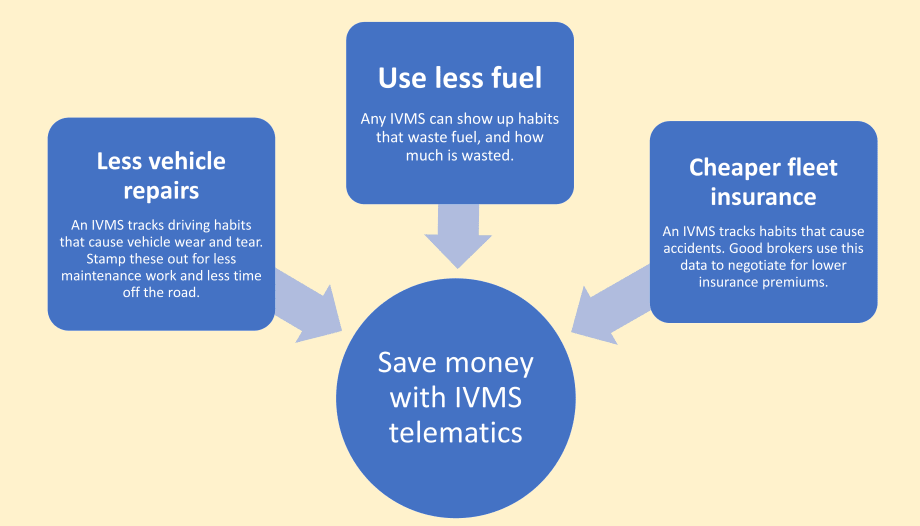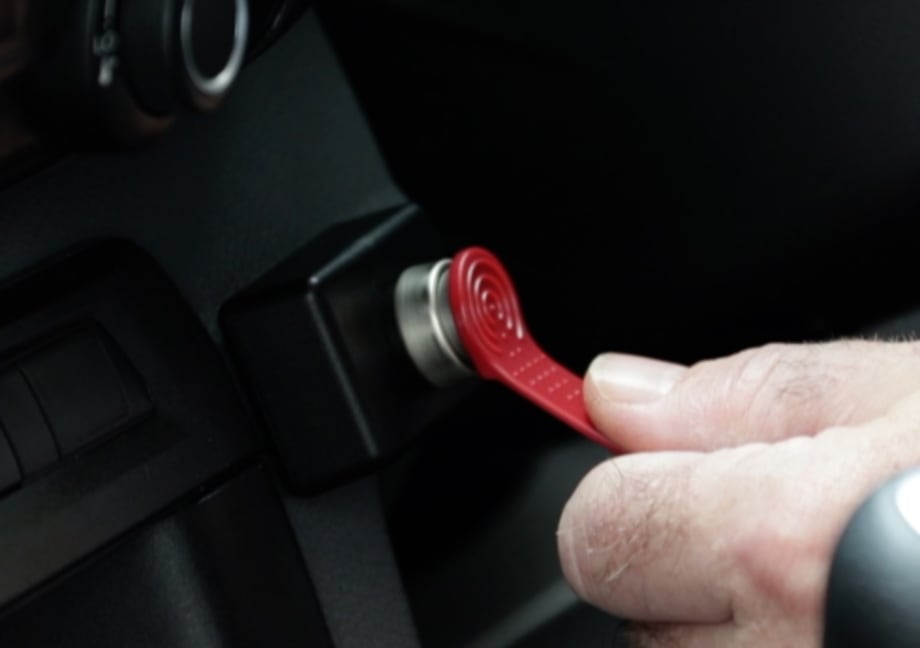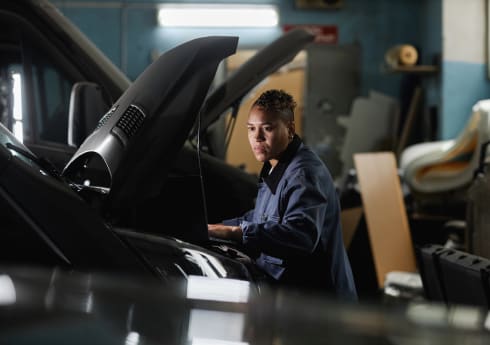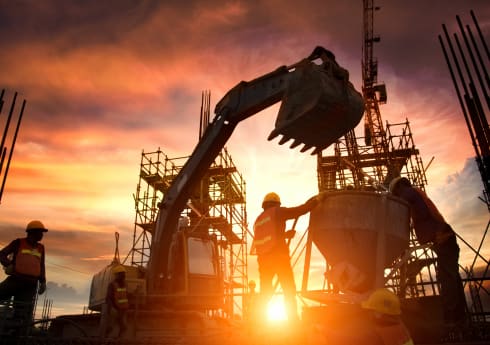What Is IVMS And How Does It Benefit Your Fleet?
How would you like to know how your drivers are treating your company vehicles? Are they driving recklessly or aggressively or are they well-behaved in traffic?
With IVMS and telematics for your business, you get to find out. You get to tackle bad driving behaviours, make sure your drivers are putting your business in a good light and ensure the safety of both the drivers and the vehicles.

What is IVMS?
An in-vehicle monitoring system, or IVMS, is a system that builds up objective evidence of how safe or risky a driver is. It tracks driving habits that increase the risk of accidents, like speeding, sudden braking and cornering too fast.
The data comes from a vehicle tracker with an accelerometer wired to the battery and ignition. Accelerometers measure the speed of vehicles accurately. If you just have a simple vehicle tracker, it can work out the rough speed using GPS location but it’s not precise like an accelerometer.
Here’s how it works:
- This device transmits a signal continuously, which goes to a server that stores all the data.
- The IVMS software converts this into an amazing amount of intelligence on the way the driver is handling the vehicle, and interacting with the road and other drivers.
- For vehicles like lorries transporting gas, oil and explosive chemicals, where a crash could be catastrophic, the IVMSS also have cameras in the cab which show if the driver is using a phone, smoking or not wearing a seatbelt.

Who is an IVMS useful for?
The potential of IVMS to reduce road accidents is well-proven. So, it’s not improbable they’ll be a mandatory part of fleet insurance for businesses sometime in the future.
Currently, IVMSs are mostly used by public transport vehicles, where driver fatigue or any reckless behaviour could have devastating consequences for a large number of people
They’re also widely used by companies involved in mining, transporting oil and gas in tankers and transporters of other potentially dangerous cargos. In companies like these, making sure drivers put safety first is obviously essential.

But IVMS as vehicle monitoring system can be useful for businesses of all sizes, small or big. It can save fleets money. It can save your small business money, even if you only have a few vehicles.
What many smaller businesses don’t realise is that using an IVMS can be very cheap. Plus, they pay for themselves every month many times over.
What’s more, many IVMS are not time-consuming to use because several very user-friendly systems are available to UK smaller businesses.
What are the main in-vehicle monitoring system features?
An IVMS will tell you where drivers go and how they handle your vehicles. Most systems focus on logging five specific driving habits:
- Speeding
- Harsh accelerating
- Cornering too fast
- Sudden braking
- Leaving the engine idling
Every time a driver does any of these, the i-VMS software within a telematics system keeps a record of the time and location. Then, each of your drivers gets a score.

Other great in-vehicle monitoring system features are its insightful reports, such as:
IVMS speeding reports
An IVMS system will tell you every time your drivers go over the limit, and by how much.
You can re-train your drivers to stay within the speed limit with “speed awareness” courses, if necessary, to reduce insurance claims.
Stopping your drivers speeding will reduce the wear and tear on your engines, meaning you don’t waste money with vehicles off the road for servicing. Keeping your drivers safe from injury by stamping out speeding is important too. As is avoiding incidents and crashes.
Harsh acceleration IVMS reports
Putting an end to “boy-racer” accelerating away from traffic lights will certainly save your business money on fuel.
Obviously you will reduce wear and tear on the throttle as well, which is damaged when undue pressure is repeatedly applied.
Reckless cornering IVMS reports
You can reduce the risk of accidents through reckless cornering, which is reported in all IVMS. Consistently, the world over, more than 50% of crashes happen on or by corners.
Persistent harsh cornering suggests a driver is not fully in control of the vehicle and such drivers are statistically far more likely to be the guilty party in a crash.
Harsh braking IVMS reports
Every incident of harsh braking is reported in an IVMS.
Reduce the risk of accidents and save money on fuel and vehicle maintenance by stamping out harsh braking. Sudden stops cause quicker wear-and-tear on the brake pads and rotors. Good drivers read the road ahead and press the pedals more smoothly.
How can an IVMS save my business money?
Lots of small businesses up and down Britain have an IVMS already as part of their telematics system, yet they never use it. Why? For some, it’s because they don’t know how to – they chose a system that is over-complicated and doesn’t present the information clearly. For others, they don’t realise how it could be useful to them, so they ignore it.
There are three main ways that an IVMS as part of your telematics system could save your business money, even if you are a really small company.
- Firstly, an IVMS tracks driving habits that cause vehicle wear and tear. Stamp these out for less maintenance work and less time off the road.
- Secondly, it can show up habits that waste fuel, and how much is wasted.
- Finally, an IVMS tracks habits that cause accidents. Good brokers use this data to negotiate lower insurance premiums on your behalf. Having fewer accidents also means the load your vehicles are transporting is at less risk of damage, and saves you hours of time dealing with insurance claims and vehicle repairs.

What are the other benefits of IVMS vehicle tracking?
Apart from the financial benefits, there are safety considerations.
- Your drivers should not be driving if they are too tired. Your IVMS can alert you to this possibility with in-app alerts or emails.
- You can also take care of your drivers should the worst happen. An IVMS can let you know the minute an accident happens so you can check if your driver needs help, and exactly where he is. Sending emergency services without delay can make a real difference to the outcome.
- In vehicle camera monitoring system can be very beneficial. For vehicles in which safety is critical, the IVMS can include cameras that face inwards and look at the driver. See if the driver is not wearing a seat belt, is using a phone, nodding off or doing anything else that could elevate the level of risk.
iCompario tip:
Before choosing a telematics system with IVMS, ask about how the data is presented. Aim for the simplest presentation possible.
Some systems have really snazzy graphs and other impressive features, but they often make it over-complicated to get to or interpret. Adding more details than you really need usually means you end up not using that functionality at all.
Incentivise drivers to help you save money with your IVMS
Most drivers suddenly start sticking to the speed limit the minute they know your vehicle tracking system has an IVMS included. This “Big Brother” effect kicks in like magic, just because they know they’re being watched. You don’t even have to log into the software and use it to start getting some benefit!

These are our suggestions that might work for your company:
- Explain it to your drivers. Talk to your team, let them know it’s used for safety and money-saving reasons, not because of lack of trust.
- Set competitions and rewards. You could print off the driver score for all your drivers at the end of each week or month and fix it up in the office or depot. If you give some kind of prize to the best driver, your other employees are likely to join in with some competition.
- Reward individual improvement. Giving benefits to individual drivers for improving over time is another approach. And it’s easy to check out how they scores improved in the telematics online management system.
How can an IVMS get my business cheaper motor fleet insurance?
Insurers are interested in three things from an IVMS when quoting an insurance premium for a business motor fleet.

The so-called risk profile, which insurance companies use to decide how much to charge you to insure a driver, is usually based on average statistics.
With telematics, your insurer can see the driver score and data for each of your drivers. With much more detail on the personal risk level of each of your drivers, the insurance company won’t have to make generalisations about how likely they are to have accidents.
In reality, your i-vms can boil all your drivers’ data down to a single number per driver. Insurance companies offering fleet insurance want to know what the average number is across all your drivers. If it’s less than one, nobody will be giving you a discount on your fleet insurance this year. If it’s more than one, you can probably shop around till you find an insurer that will.
What to look for when choosing an IVMS
The thing that distinguishes one system from another is how they present the data to you.
Some telematics systems pull out all the stops with graphs, tables you can customise umpteen ways, and statistics broken down to tiny details.
They tend to look colourful and impressive. If you enjoyed maths at school and, most importantly, have the time in your working day to read and digest this level of data, then this is the type of system you will most appreciate.
If you don’t have the time or always got a headache from maths anyway, look for something clear and simple instead. There are some systems that just spit out the key numbers and give you everything in a ready-made and digestible format. For the vast majority of businesses, this is all they need to gain all the cost savings and safety improvements that we’ve explored on this page.
We’ll help you quickly identify the right telematics system for your business. Give us a minute of your time, then we’ll work our magic.



